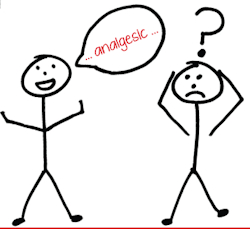Study emphasizes patient communication ‘in plain English, please'
By Qun Tang, RDH, MS
"Is my doctor speaking in a foreign language?" "In plain English, please."
You may hear those words from confused patients in your practice. Dental terminology has long been recognized as a specialized language that is acquired through education and clinical practice. In dental clinics, patients often have difficulty understanding some information provided to them, such as options for treating oral diseases, and instructions for oral home care, prevention, and maintainence. Not understanding medical concepts could have significant consequences for patients and their oral health-care providers.
Much of the problem stems from differences between the language used by clinicians and that used by the public. Laypersons and health-care professionals express and think about health-related concepts differently. For example, a layperson may understand loss of appetite instead of anorexia, and use painkiller instead of analgesic.
Consumer Health Vocabulary (CHV)
Mismatches in language hinder effective communication in dental hygiene clinics every day. During face-to-face communication, patients may ask dental hygienists for clarification if they become confused. Some patients may choose not to ask for some reason, even though they want clarification. Patients appreciate that a dental hygienist can share ideas using everyday words. Clinical documents are "static" and based on the knowledge and judgment of dental professionals. Some patients, especially those with lower income levels and literacy skills, have difficulty comprehending dental documents. It could be helpful to customize information and make it patient friendly to facilitate comprehension for patients.
--------------------------------------------------------------
Consider reading these articles
- No More No-shows
- Your dental practice: To text or not to text?
- 12 Questions to Improve Patient Communication
--------------------------------------------------------------
Patients' ability to comprehend something decreases as the number of "difficult" medical words increases. Substituting simple and familiar words improves their understanding. In 2001, International Medical Informatics Association (IMIA) started developing ‘‘consumer health vocabularies'' (CHVs).1 One of the definitions of a CHV is that it links everyday words and phrases about health (for instance, heart attack) to technical terms or jargon used by health-care professionals (myocardial infarction).2
Health information presents additional challenges. It not only contains unfamiliar and difficult words, but also abounds with complex concepts such as those related to physiology and pharmacology. The development of a consumer vocabulary should be based on research that includes consumer information needs and consumers' ways of expressing those needs. The lay health language should be stable. Are the health-related words used by consumers sufficiently consistent to develop CHVs? The researchers have to address this question about the feasibility of developing useful CHVs.
In 2004, researchers presented the preliminary results of the distributed CHV development experiment at the Consumer Health Informatics Working Group meetings of the American Medical Informatics Association (AMIA). During the past 10 years, a computerized collection of health expressions has been developed and updated. Those vocabularies are derived from actual consumer utterances (authored by consumers) and linked to professional concepts. For example, sources of consumer-authored texts included email messages, online health discussion group postings, queries submitted to consumer health websites, and folk terms from the English dictionaries. Some research studies focused on particular medical domain areas, such as cancer.3 All the studies mapped consumer expressions to the components of the National Library of Medicine (NLM) Unified Medical Language System (UMLS) Metathesaurus.4 They are reviewed and validated by professionals and consumers. The first-generation CHVs were developed and shared for the public in an open-access website.2
CHVs could support patients in their search for oral health information on the Internet. Professional terms are likely to produce better search results than consumer expressions. CHVs would facilitate automated mapping of consumer-entered queries to technical terms (e.g., gum inflammation for gingivitis; specialty of oral surgery for maxillofacial surgery; dry mouth for xerostomia; soreness of tongue for glossodynia, and more). The dental records and test results becoming available to patients frequently contain jargon. A CHV could supplement the jargon with consumer-friendly display names. Potentially, CHV could help patients in email communication with doctors,5 decision support,6 and disease management.7
A Small Study in Dental Hygiene Clinic
A small study about CHV was conducted at Milwaukee Area Technical College (MATC). Clinical documents in the dental hygiene clinic at MATC, such as medical/dental history, patient treatment plans, and patient instructions following scaling and root detoxification, were reviewed. A list of technical terms in those clinical documents was selected. Using open-access and collaborative (OAC) consumer health vocabulary (CHV), I found CHV expressions related to selected technical terms, including decrease for diminish; swelling due to excess fluid for edema; drugs causing loss of sensation for anesthetic; pain relieving drug for analgesic; drug therapy for chemotherapy, and more. We created a consumer-friendly display of the clinical document by replacing technical terms with general language expressions in CHVs. A preliminary analysis was conducted to compare the two versions.
Obviously, CHV will be domain specific. For example, I found that the CHV translation of scaling to skin peeling is not accurate for dental hygiene clinic, and scaling in our dental hygiene area mainly refers to calculus removal. Through local uses of CHV in the various health professional fields, health-care providers can provide feedback to CHV researchers and contribute new alternative data to CHV.
The study at MATC found that most of the current CHV expressions are the same as technical terms in dental clinical documents, so CHV is far from perfect in today's clinic. First-generation CHVs are likely to serve as a platform for incremental improvements in the future.
Hopefully this article will increase awareness of the current consumer health vocabulary research results and introduce CHV to dental hygienists' daily practice. Researchers in consumer health informatics working groups in AMIA are tackling small pieces of the larger problem, bridging the communication gap between patients and health-care professionals. Only through an interdisciplinary effort by both researchers and health-care providers, including dental hygienists, can we anticipate that the next generation of CHV will be better and that a better understanding of the overall phenomenon will result.
Qun Tang, RDH, MS, is an instructor in the department of dental hygiene, School of Health Sciences at Milwaukee Area Technical College. She can be reached at [email protected]. References
1 Lewis D, Brennan PF, McCray AT, et al. If we build it, they will come: standardized consumer vocabularies. Medinfo. 2001; 10:1530.
2 Open Access, Collaborative, Consumer Health Vocabulary Initiative Website: Available at http://www.consumerhealthvocab.org/, Accessed October 13, 2013.
3 Smith CA, Stavri PZ, Chapman WW. In their own words? A terminological analysis of e-mail to a cancer information service. Proc AMIA Symp. 2002;697–701.
4 Unified Medical Language System (UMLS) Website: Available at http://www.nlm.nih.gov/research/umls/, Accessed October 3, 2013.
5 Delbanco T, Sands DZ. Electrons in flight--e-mail between doctors and patients. N Engl J Med. 2004;350: 1705–7.
6 Bouhaddou O, Lambert JG, Miller S. Consumer health informatics: knowledge engineering and evaluation studies of medical House Call. Proc AMIA Symp. 1998;612–6.
7 Ralston JD, Revere D, Robins LS, Goldberg HI. Patients experience with a diabetes support programme based on an interactive electronic medical record: qualitative study. BMJ. 2004; 328:1159.







